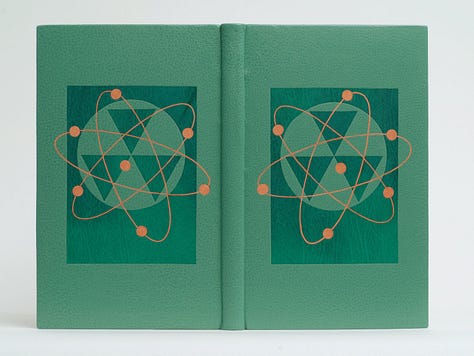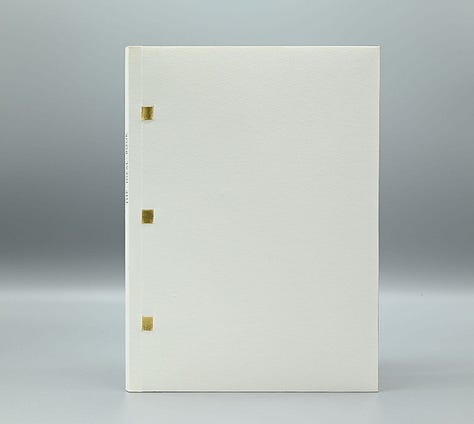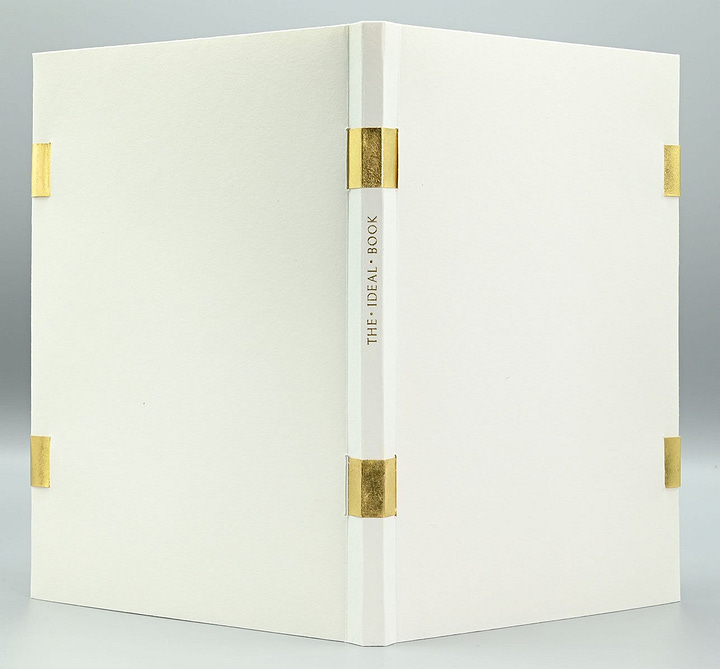As those who have followed this blog since its inception, our first publicly-available project was a facsimile edition of T.J. Cobden-Sanderson’s The Ideal Book, a seminal statement of the Arts and Crafts ethos as applied to the book. Just 16 pages long, it still provided me with plenty of fodder for reflection on topics ranging from calligraphy and typography to the history of the Arts and Crafts movement and the design decisions that even a facsimile version required.
Whereas our version was an attempt to create as faithful a facsimile of the original as possible, many others have applied their own vision to the printing and binding of this small book over the years (https://ampersandbookstudio.substack.com/p/the-fine-press-essay).
Today, I was inspired to see the new bindings of the essay by the remarkable Karen Hanmer. Using our letterpress printed pages, Karen has created a creatively modern take on the vellum binding originally used by Cobden-Sanderson for The Ideal Book and other publications at his Doves Press.
Our In-Pages Editions
There are more bookbinders in the world than there are small presses printing entire books using letterpress. As a result, it is often difficult for them to find high-quality texts for their fine bindings. Frequently, they resort to simply printing a PDF of a book whose copyright has expired and is now in the public domain. Some even dismantle existing books just to have a text onto which they are able to add an artistic binding. From the start, one of my commitments was to make a small number of copies of our books accessible to bookbinders in the hope that it would provide the foundation for inspired bindings beyond those of Ampersand Book Studio.

When Karen’s bindings of The Idea Book came across my social media feed, it once again confirmed that the decision to make our printed pages available to others was one that supports a vibrant and dynamic book arts community.
Karen Hanmer and The Ideal Book
As I have written previously, Karen Hanmer (https://karenhanmer.com/) is one of the most knowledgeable and talented bookbinders in the world today. Her artist books and design bindings are spectacular. Over the last three decades, her books have been added to the collection of the British Library, the Library of Congress, as well as private collections.






In addition to her own creative work, Karen is a scholar and teacher of historic binding structures. Indeed, her research and teaching about the structure of Cobden-Sanderson’s The Ideal Book were instrumental to my own process of creating a facsimile edition. In appreciation of her guidance, I sent Karen a couple of copies of the “in-pages” version for her own use. What she has now created is two remarkable copies of the essay:






Karen shares her thoughts on these new bindings:
I wanted a modern, enthusiastic-opening update to the original limp vellum case. I chose a paper to match rather than contrast the very bright white text. The green thread, use of at least some vellum, and the gratuitous use of gold are all nods to the work of Cobden-Sanderson.
In addition to aesthetic considerations, Karen also sought to solve one of the challenges of Cobden-Sanderson’s bindings: despite being called a “limp vellum binding,” they tend to be quite stiff. Opening them – at least for the first few hundred or so readings – can be a bit of a challenge as you can see when I flipped through the pages of their 1906 edition of Emerson. The book just did not want to stay open!
For her modified version, Karen opted to use a handmade linen paper from the Anglo-Franco Ruscombe Mill for the cover, a much softer and more pliable material than vellum. Karen reserved vellum– gilt in this case – for straps that are both decorative and structural, tying the book together in both an aesthetic and mechanical manner.


Seeing the ways in which other people involved in the book arts interpret projects is stimulating, challenging us all to continue to both look to tradition and innovate upon it. As of this writing, both copies are available for purchase on Karen’s website: https://karenhanmer.com/gallery/p/ideal-book-unsupported and https://karenhanmer.com/gallery/p/ideal-book-supported.
If you are interested in creating your own binding for The Idea Book, a few copies of our in-pages version are still available on our website.
Studio Updates
The marbled paper I discussed in last week’s post has arrived safe and sound at our Tucson studio. I am so grateful to Jemma Lewis for sharing her artistry as a part of our edition of Master and Commander. It will still be a while before I am ready to cover the books with these lovely papers; in the meantime, their beauty continues to inspire.




